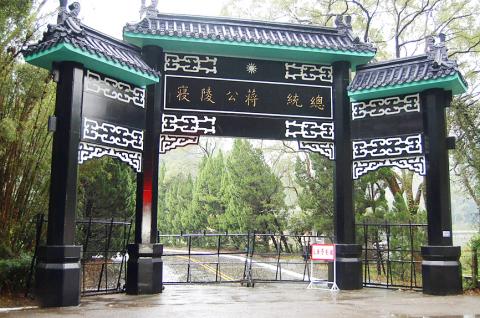A senior government official yesterday warned that the mausoleum of former president Chiang Ching-kuo (蔣經國) might be in danger due to its proximity to a faultline.
The bodies of Chiang Kai-shek (蔣介石) and his son Chiang Ching-kuo were not buried. Chiang Ching-kuo’s body was preserved at a mausoleum in Taoyuan’s Dasi District (大溪) and Chiang Kai-shek’s remains were entombed at a mausoleum in Tzuhu (慈湖).
Both mausoleums are old and require a lot of money to repair, said the official, who declined to be named, adding that repairs last year to the Chiang Ching-kuo mausoleum cost NT$13.2 million (US$408,289), while the Tzuhu mausoleum cost NT$10.4 million.

Photo: Tsai Chia-yen, Taipei Times
The official said that Chiang Ching-kuo building has cracks and has leaked since its commissioning in 1988 and the structure is slowly deteriorating.
Another point of concern is that the Chiang Ching-kuo site is only 195m from the Sindian faultline, which passes through the entire Taoyuan area, the official said, adding that the government has yet to make a complete assessment of the area after the 921 Earthquake in 1999.
“We are still uncertain whether the area around the mausoleum suffers from subsidence and without that assessment, we cannot make plans or changes to the design,” the official said.
The Sindian faultline runs through northern Taiwan, including Sindian District (新店) in Taipei, which gives it the name. The southern tip of the fault is in Dasi.
The Presidential Office and the Ministry of National Defense’s Reserve Command jointly said that should the Chiang family make a decision, the public cemetery on Wuchih Mountain (五指山) in New Taipei City’s Sijhih District (汐止) has been set up to hold the bodies.
The “Chiang Ling” (Chiang Tomb, 蔣陵) — the first of its kind built on government land using government funds — was completed in 2005 following talks with the Chiang family about moving the bodies. It features a plaque hung over the entrance, which is a Chinese-style archway, reminiscent of imperial China.
Spaces inside the site for epitaphs and commendations have been left blank.
The Chinese word ling is usually reserved for nobility and royals in ancient China, while the word grave or tomb is usually denoted by the Chinese word fen mu (墳墓).
The construction of the Chiang Ling cost NT$31.4 million.
Since the passing of Chiang Kai-shek’s wife, Soong Mayling (宋美齡), in 2003, the family has lacked an individual who can make decisions on behalf of the whole family, the official said.
Despite multiple efforts by all levels of the government, the Chiang family remains divided on the issue of moving the bodies, the official said, adding that after being unused for 11 years, the Wuchih Mountain site might remain that way for years to come.

Taiwan is to commence mass production of the Tien Kung (天弓, “Sky Bow”) III, IV and V missiles by the second quarter of this year if the legislature approves the government’s NT$1.25 trillion (US$39.78 billion) special defense budget, an official said yesterday. Commenting on condition of anonymity, a defense official with knowledge of the matter said that the advanced systems are expected to provide crucial capabilities against ballistic and cruise missiles for the proposed “T-Dome,” an advanced, multi-layered air defense network. The Tien Kung III is an air defense missile with a maximum interception altitude of 35km. The Tien Kung IV and V

The disruption of 941 flights in and out of Taiwan due to China’s large-scale military exercises was no accident, but rather the result of a “quasi-blockade” used to simulate creating the air and sea routes needed for an amphibious landing, a military expert said. The disruptions occurred on Tuesday and lasted about 10 hours as China conducted live-fire drills in the Taiwan Strait. The Civil Aviation Administration (CAA) said the exercises affected 857 international flights and 84 domestic flights, affecting more than 100,000 travelers. Su Tzu-yun (蘇紫雲), a research fellow at the government-sponsored Institute for National Defense and Security Research, said the air

Taiwan lacks effective and cost-efficient armaments to intercept rockets, making the planned “T-Dome” interception system necessary, two experts said on Tuesday. The concerns were raised after China’s military fired two waves of rockets during live-fire drills around Taiwan on Tuesday, part of two-day exercises code-named “Justice Mission 2025.” The first wave involved 17 rockets launched at 9am from Pingtan in China’s Fujian Province, according to Lieutenant General Hsieh Jih-sheng (謝日升) of the Office of the Deputy Chief of the General Staff for Intelligence at the Ministry of National Defense. Those rockets landed 70 nautical miles (129.6km) northeast of Keelung without flying over Taiwan,

A strong continental cold air mass is to bring pollutants to Taiwan from tomorrow, the Ministry of Environment said today, as it issued an “orange” air quality alert for most of the country. All of Taiwan except for Hualien and Taitung counties is to be under an “orange” air quality alert tomorrow, indicating air quality that is unhealthy for sensitive groups. In China, areas from Shandong to Shanghai have been enveloped in haze since Saturday, the ministry said in a news release. Yesterday, hourly concentrations of PM2.5 in these areas ranged from 65 to 160 micrograms per cubic meter (mg/m³), and pollutants were